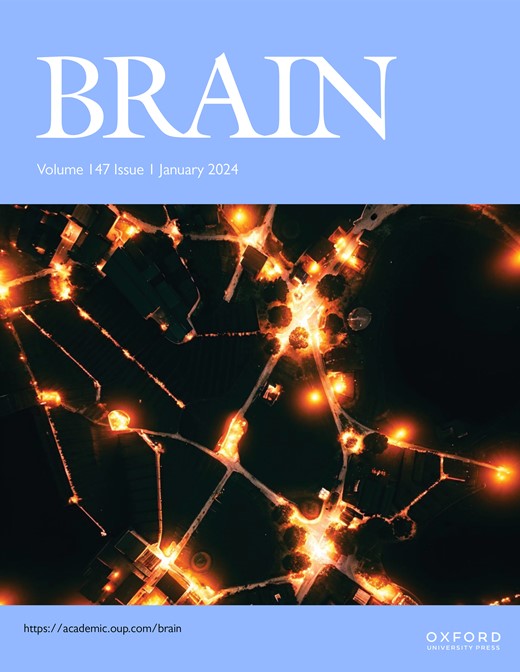Cholinergic patterns correlate with dopamine medication ON freezing of gait in Parkinson’s disease
IF 11.7
1区 医学
Q1 CLINICAL NEUROLOGY
引用次数: 0
Abstract
Gait problems in people with Parkinson’s (PD) are increasingly common as disease progresses. Symptoms include freezing of gait (FoG), and a predisposition to falls. The causative pathophysiology is still not completely understood. In this study, Positron Emission Tomography (PET) with 18F-fluoro-ethoxy-benzovesamicol (18F-FEOBV), a presynaptic marker of cholinergic terminal density, and 18F-fluoro-deoxy-glucose (18F-FDG) was performed in a cohort of people with PD and gait disorder to derive spatial covariance networks of cholinergic and metabolic activity, and to evaluate the correlation of such networks against frequency of FoG and other gait measures. Fourteen patients with PD and FoG in the ON motor state underwent PET using 18F-FEOBV and 18F-FDG on two separated days. Following spatial normalization, functional networks were derived by Principal Component Analysis (PCA). The individual expression of linear combinations of principal components (PCs) was subsequently correlated with measures of FoG in the ON motor state (ON-FoG) and a lower body and gait (LBG) subsection of the Unified Parkinsons Disease Rating Scale (UPDRS) part III. Gait measures were derived from home-worn measures using a triaxial accelerometer. We found a derived pattern of 18F-FEOBV binding that correlated with ON-FoG (R2= 0.46975, p = 0.045) as well as other lower body and gait signs (R2 = 0.78591, p = 0.0077). Lower levels of cholinergic activity in the thalamus, hippocampus, striatum, anterior cingulate as well as areas of the brainstem consistent with the mesencephalic locomotor region were associated with worse ON-FoG and gait disturbances. The derived pattern was not associated with overall disease duration or progression as assessed by standard motor scores. There was no correlation between 18F-FEOBV and OFF-FoG. For 18F-FDG, no correlation between covariance patterns and gait assessments could be found. However, a statistically significant correlation was found for a subset of lower body and gait symptoms (R2 = 0.78306, p = 0.002). These results exhibit a correlation between lower levels of cholinergic function in locomotor-related areas of the brainstem and objective measures of dopamine medication ON-FoG, potentially indicating a causative link between the two. No association was found with OFF-FoG. Taken together our results provide support for the role of the cholinergic system in the occurrence of dopamine medication ON-FoG.胆碱能模式与多巴胺药物在帕金森病中冻结步态相关
随着疾病的进展,帕金森病患者的步态问题越来越普遍。症状包括步态冻结(FoG)和易跌倒。病因病理生理学尚不完全清楚。在这项研究中,正电子发射断层扫描(PET)与18f -氟-乙氧基-苯并维氨基醇(18F-FEOBV),一种突触前标记的胆碱能末端密度,和18f -氟-脱氧葡萄糖(18F-FDG)在PD和步态障碍患者队列中进行,以获得胆碱能和代谢活动的空间协方差网络,并评估这些网络与FoG频率和其他步态测量的相关性。14例处于ON运动状态的PD和FoG患者分别在两天内使用18F-FEOBV和18F-FDG进行PET扫描。在空间归一化之后,通过主成分分析(PCA)导出功能网络。主成分线性组合(PCs)的个体表达随后与运动状态(ON-FoG)的FoG测量以及统一帕金森病评定量表(UPDRS)第三部分的下体和步态(LBG)部分相关。步态测量来自使用三轴加速度计的家装测量。我们发现18F-FEOBV结合模式与ON-FoG (R2= 0.46975, p = 0.045)以及其他下体和步态标志(R2= 0.78591, p = 0.0077)相关。丘脑、海马体、纹状体、前扣带以及脑干与中脑运动区一致的区域胆碱能活性水平较低与更严重的ON-FoG和步态障碍相关。通过标准运动评分评估,衍生模式与总体疾病持续时间或进展无关。18F-FEOBV与OFF-FoG无相关性。对于18F-FDG,协方差模式与步态评估之间没有相关性。然而,下体症状和步态症状之间存在统计学上显著的相关性(R2 = 0.78306, p = 0.002)。这些结果表明脑干运动相关区域胆碱能功能水平较低与多巴胺药物ON-FoG的客观测量之间存在相关性,可能表明两者之间存在因果关系。与OFF-FoG没有关联。综上所述,我们的结果支持胆碱能系统在多巴胺药物ON-FoG发生中的作用。
本文章由计算机程序翻译,如有差异,请以英文原文为准。
求助全文
约1分钟内获得全文
求助全文
来源期刊

Brain
医学-临床神经学
CiteScore
20.30
自引率
4.10%
发文量
458
审稿时长
3-6 weeks
期刊介绍:
Brain, a journal focused on clinical neurology and translational neuroscience, has been publishing landmark papers since 1878. The journal aims to expand its scope by including studies that shed light on disease mechanisms and conducting innovative clinical trials for brain disorders. With a wide range of topics covered, the Editorial Board represents the international readership and diverse coverage of the journal. Accepted articles are promptly posted online, typically within a few weeks of acceptance. As of 2022, Brain holds an impressive impact factor of 14.5, according to the Journal Citation Reports.
 求助内容:
求助内容: 应助结果提醒方式:
应助结果提醒方式:


